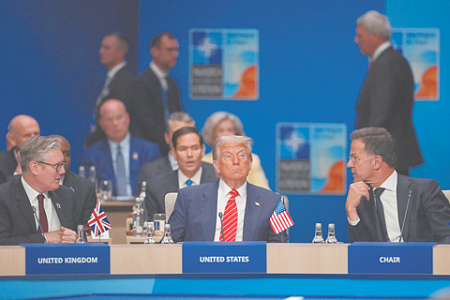
In a move echoing Cold War-era strategy, a NATO summit in The Hague has officially designated Russia as the primary long-term threat to Euro-Atlantic security. The alliance’s final declaration, which also named terrorism as a persistent danger, conspicuously omitted any mention of China or Iran in a similar capacity. In a landmark decision, all member states agreed to a dramatic increase in military expenditures, committing to a target of 5% of GDP for defense by 2035, a figure not seen since the height of the standoff with the Soviet Union.
The declaration states that allies are “United in the face of profound security threats and challenges, in particular the long-term threat that Russia poses to Euro-Atlantic security.” This renewed focus was succinctly captured by Finnish President Alexander Stubb, who told journalists, “We are returning to the roots of the alliance. In other words, to a collective, complex system for deterring Russia.” While the commitment to a 5% spending target is now on paper, its practical implementation remains uncertain, given the alliance’s ongoing struggle to have all members meet the previous 2% goal set in 2014.
Summit participants deliberately sidestepped recent turmoil in the Middle East, choosing not to publicly debate the contentious US-Israel military action against Iran. This came despite conflicting reports casting doubt on President Donald Trump’s assertion that Iran’s nuclear program had been decisively crippled. While the White House refuted intelligence leaks suggesting minimal damage to key facilities like the Fordo plant, both Iranian and Israeli military officials indicated that the conflict was merely paused, not concluded, and that Tehran’s nuclear capabilities were not fully eliminated.
Amid the hawkish stance on Russia, the summit’s language regarding Ukraine revealed a delicate diplomatic balancing act. The new declaration offered a more generalized commitment to supporting Ukraine, a shift from the previous year’s explicit statement that the country was awaited in NATO. This ambiguity aligns with President Trump’s past remarks ruling out Ukraine’s membership. However, NATO Secretary General Mark Rutte provided crucial clarification, stating that previous alliance decisions remain in effect unless formally overturned and reaffirming support for Ukraine’s “irreversible path to NATO membership.” This was further reinforced by a reportedly benevolent meeting between Trump and Ukrainian President Volodymyr Zelenskyy during the summit.
Securing a unanimous signature on the declaration marked a significant victory for the alliance’s leadership, demonstrating a united front despite public reservations from leaders like Hungary’s Viktor Orbán, who refused to label Russia a threat, and Spain, which was displeased with the spending hikes. This display of unity, however, papers over deep-seated questions of practical application. The alliance’s past performance on defense spending suggests that the new, ambitious target may face significant hurdles, even as President Trump continues his unwavering insistence that European nations must cease relying on American protection and invest decisively in their own security.
